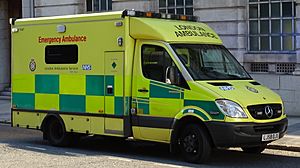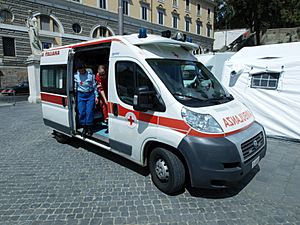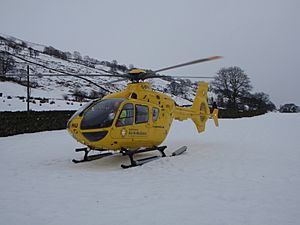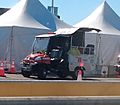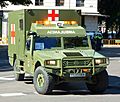Ambulance facts for kids
An ambulance is a type of vehicle made to carry sick or injured people. Normally, ambulances go to people in emergencies to take people to hospital. Examples of emergencies include heart attacks, strokes, serious bleeding, broken bones, chest pain, serious head injuries, trouble breathing, and people injured in situations like car crashes and falls.
The first ambulances were used on battlefields, when horse-drawn carts carried badly wounded soldiers to field hospitals after the battle. Horse-drawn ambulances became commonplace in Europe and North America in the 19th century, as hospitals became common. Automobiles replaced horses in the early 1900s. Today's ambulances are vans which are converted into small mobile clinics. They can provide first aid, emergency care, various medicines and life support, and carry patients to hospital.
Ambulances normally have emergency medical technicians (EMTs) and paramedics who work on them. They carry medicines and special equipment that can keep people alive. They also carry advanced tools for delivering babies in an emergency and restarting a heart.
Ambulances are normally called by dialing a special emergency number, which is different from country to country. In the United Kingdom, this number is 999; United States 911; Europe 112. An emergency medical dispatcher then sends an ambulance.
Contents
Crew
An ambulance usually has two crew members. That way, one can drive while the other looks after the patient in the back. A paramedic will have at least a year of medical training, and can do fairly advanced treatment. Not all ambulance staff are paramedics. Those with less training are known as emergency medical technicians (EMTs) in some countries such as the United States, and emergency care assistants (ECAs) in the United Kingdom. In some countries such as France, Germany, the Netherlands and Sweden, ambulances may have doctors or nurses on board.
Equipment
In the past, ambulances only gave patients a ride to hospital, or only had a first aid kit. This is still true in some parts of the world. In modern times, ambulances will have far more equipment and medicine. In some countries, an ambulance is like a mobile doctor's clinic.
As well as medicine and bandages, ambulances often have these things:
- Collar: A special collar holds someone's neck in place if they have damaged their backbone.
- Defibrillator: An electric shock machine for restarting a stopped heart.
- Entenox gas cylinders: Also known as "laughing gas". This gas reduces pain if it is breathed in.
- Heart monitor: This machine shows how well a heart is beating.
- Oxygen gas cylinders: There is some oxygen in the air all around us. But if a person is struggling to breathe, it often helps to give them oxygen from a cylinder. They will wear a small mask when this is done.
- Splints: These hold an arm or leg in place if a bone is broken, to stop the broken bone from getting worse.
- Stretcher or scoop: For carrying the patient in and out of the ambulance.
- Wheelchair: Another way to carry a patient.
When driving in an emergency, ambulances can break some road laws. For example, they can drive over the speed limit and through a red traffic light. They have flashing lights and sirens to warn traffic along the way.
Air ambulance
Air ambulances became more common in the late 20th century. Helicopters carry the same kind equipment as a typical ground ambulance. In the United States, the Coast Guard runs a public air ambulance service using helicopters. There are also privately owned air ambulance services that provide for a wider range of needs, including international transport.
Air ambulances are especially important in countries with low population density (few people, living in a vast area) such as Canada, Russia, midwest USA, Sweden or Finland. They can often save a life of a patient who would otherwise die because he could not be carried fast enough to hospital by other means.
Images for kids
-
Fiat Ducato ambulance in Great Britain
-
Queen Elizabeth II (then Princess) next to British Army ambulance in 1945
-
Early car-based ambulances, like this 1948 Cadillac Meteor, were sometimes also used as hearses.
-
Many modern Canadian and European ambulances are built on the Mercedes-Benz Sprinter chassis. Some, like this Niagara Region example, use custom rear compartments.
-
Van-based Volkswagen Crafter in Czech Republic
-
Interior of a mobile intensive care unit (MICU) ambulance from Graz, Austria
-
An ambulance in New South Wales, Australia with warped Battenburg markings, The Maltese Cross and additional fluorescent reflective stripes to aid in visbility. Ample emergency lighting has also been fitted
-
An ambulance from St John Ambulance WA in Perth
-
A volunteer ambulance crew in Modena, Italy
-
Various ambulance crews help to load a patient into an air ambulance in Pretoria
-
Retired ambulances may find reuse in less-demanding emergency services, such as this Ford E-Series former ambulance that has become a logistics unit.
-
Ambulance in Switzerland
-
New York City Fire Department
-
Toyota HiAce Commuter ambulance in Malaysia
-
A van bodied ambulance built for the Abu Dhabi National Ambulance
-
Audi A4 Avant fly-car in Germany
-
An air ambulance in Austria
-
An air ambulance in Australia
-
A water ambulance in the Scilly Isles
-
Norwegian boat ambulance operating on the coast of Helgeland.
-
A typical American ambulance, operated by the Longboat Key fire department.
See also
 In Spanish: Ambulancia para niños
In Spanish: Ambulancia para niños


